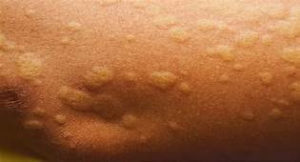Cat, Dog, and Other Pet Allergies
 Twenty percent of the U.S population have cat allergies and 10% of the population have dog allergies. In the U.S., the most common pet are dogs, which are followed by cats as the second most common pet. Approximately 70% of homes having at least one pet. This is a higher percentage of homes with pets than in the past as more and more families are acquiring pets. In addition to cats and dogs, some other common pets include birds (e.g., parakeets, parrots), fish, rabbits, rodents (e.g., guinea pigs, hamsters, gerbils, chinchillas, rats, mice) reptiles (e.g., snakes, lizards, turtles, geckos), hermit crabs, ferrets, horses, and spiders. Horses normally do not live in people’s homes, but they may be rather allergenic. In recent years, there is a fad of owning miniature horses which in some cases do live in their owner’s house. This is probably not a good idea in general, but for those who are allergic to horses, it is especially unwise.
Twenty percent of the U.S population have cat allergies and 10% of the population have dog allergies. In the U.S., the most common pet are dogs, which are followed by cats as the second most common pet. Approximately 70% of homes having at least one pet. This is a higher percentage of homes with pets than in the past as more and more families are acquiring pets. In addition to cats and dogs, some other common pets include birds (e.g., parakeets, parrots), fish, rabbits, rodents (e.g., guinea pigs, hamsters, gerbils, chinchillas, rats, mice) reptiles (e.g., snakes, lizards, turtles, geckos), hermit crabs, ferrets, horses, and spiders. Horses normally do not live in people’s homes, but they may be rather allergenic. In recent years, there is a fad of owning miniature horses which in some cases do live in their owner’s house. This is probably not a good idea in general, but for those who are allergic to horses, it is especially unwise.
Allergies to pets are in fact really an allergy to the specific proteins that are produced by a particular pet. In dogs, the major protein responsible for allergies to dogs is called “Can f 1.” This protein produced by dogs is most commonly found in the dog’s dander, saliva, and urine. In cats, the major proteins associated with allergies are known as “Fel d 1” and “Fel d 4.” These two proteins are responsible for most of the suffering in individuals with cat allergies. Similarly, most of the proteins that cause allergies in cats are concentrated in the sebaceous glands in the skin (i.e., dander), the saliva, and the urine. Unlike dogs, cat dander tends to “stick” to things such as walls, carpeting, clothing, bedding, etc. and is commonly transported from the home to home or home to work environments. If the Fel d 1 protein is measured on a cat owner’s clothing, bedding, or upholstered furniture at work, it is likely that the protein will be found. In addition, it may take months for these proteins to dissipate and become undetectable, despite a thorough cleaning of the home, due the stick-to-itiveness of cat dander. Note that since the protein is also found in urine, cat litter boxes are a rich source of these proteins and allergic individuals should avoid exposure to litter boxes. In dogs, fortunately the protein Can f 1 is not as “sticky” as the cat proteins, but still can adhere to walls, clothing, carpeting, bedding, etc. Interestingly, there is an increased incidence of horse allergy in some individuals that have cat and/or dog allergies due to a common protein that is shared between all three animals. In rodents, in addition to the allergenic protein being present in the urine, dander, and saliva, certain rodents such as mice contain allergenic proteins in their mouse droppings.
In addition to pet allergies, there are additional potential medical hazards to consider when owning certain pets. Mice and rats carry many diseases such as the bubonic plague, Hantavirus pulmonary syndrome (HPS), leptospirosis, tularemia, rat bite fever (RBF), lymphocytic choriomeningitis, salmonellosis, and Lassa fever. Exposure to birds can cause infections and diseases such as psittacosis, salmonellosis, allergic alveolitis, campylobacteriosis, avian flu, avian tuberculosis, Newcastle disease, cryptosporidiosis, and giardiasis. Reptiles can irritate one’s skin. Snakes can cause life-threatening allergic reactions from the venom that is introduced from a snake bite.
As a general rule, if an individual is allergic to a specific pet, it is advisable not to own that pet. Even though this seems pretty obvious, a majority of individuals still choose to either acquire a pet or keep an existing pet that they own despite that the pet causes unwanted allergy symptoms. This is understandable, although not advisable, since a pet becomes a member of the family and often causes great happiness.
One myth to debunk is that there are “hypoallergenic” cats and dogs to get if one is allergic to such a pet. While some pet-allergic individuals feel that they have reduced allergic symptoms around short-haired cats and/or dogs that do not shed (e.g., poodles), most scientific studies do not support this phenomena.
Obviously, the best way to combat pet allergies is to completely avoid them as mentioned above. If this is not an option, one can take some measures to reduce their exposure to the allergens that cause pet allergies. Brushing your cat or dog frequently and bathing your cat or dog often will help reduce the levels of cat and proteins. It is also advisable to prevent the pet from entering your bedroom.
The symptoms of pet allergies are similar to any other type of environmental allergy. The symptoms may include sneezing, runny nose, nasal congestion, post-nasal drip, itchy eyes, watery eyes, redness of the eyes, puffy eyes, headaches, sinus congestion, itchy skin (i.e., pruritus), hives (i.e., urticaria), wheezing, chest tightness, coughing, and/or shortness of breath.
The treatment of pet allergies begins with avoidance of the offending pet as previously mentioned. Medications used for the management of pet allergies may include antihistamines, decongestants, leukotriene antagonists, nasal corticosteroids, nasal antihistamines, nasal anticholinergics, and/or asthma inhalers. Allergy shots (i.e., allergy injections, allergy immunotherapy, allergy desensitization, allergy hyposensitization) are very effective in treating pet allergies as they are also very efficacious in the management of dust mite, mold, and pollen allergies. They work in 80-85% of patients with allergies and have been used in the U.S. for more than 100 years.
The board certified allergists at Black & Kletz Allergy have 3 offices in the Washington, DC, Northern Virginia, and Maryland metropolitan area and treat both adults and children with pet allergies. We have offices in Washington, DC, McLean, VA (Tysons Corner, VA), and Manassas, VA. Black & Kletz Allergy offers on-site parking at each of their 3 office locations and the Washington, DC and McLean, VA offices are also Metro accessible. There is a free shuttle that runs between our McLean, VA office and the Spring Hill metro station on the silver line. To make an appointment, please call our office or you can click Request an Appointment and we will respond within 24 hours on the next business day. Black & Kletz Allergy has been serving the asthma and allergy needs of the DC metro area community for more than 50 years and we strive to offer high quality allergy and asthma care in a compassionate professional environment.

 As we are in the Fall season and approaching Winter, many individuals may experience a clear runny nose, post-nasal drip, sneezing, sore throat, nasal congestion, sinus pressure, headache, coughing, and/or fatigue. The question to many becomes, “Do I have a common cold or do I have Fall/Winter allergies? It is a common question to an even more common complaint. How does someone know if they are having allergies rather than the common cold? Well, if someone does not have a history of
As we are in the Fall season and approaching Winter, many individuals may experience a clear runny nose, post-nasal drip, sneezing, sore throat, nasal congestion, sinus pressure, headache, coughing, and/or fatigue. The question to many becomes, “Do I have a common cold or do I have Fall/Winter allergies? It is a common question to an even more common complaint. How does someone know if they are having allergies rather than the common cold? Well, if someone does not have a history of  A mast cell is a component of the immune system that is involved in the allergic response. Mast cells contain histamine and other chemical mediators. These chemicals are released into the bloodstream and then into the surrounding tissues during an allergic reaction.
A mast cell is a component of the immune system that is involved in the allergic response. Mast cells contain histamine and other chemical mediators. These chemicals are released into the bloodstream and then into the surrounding tissues during an allergic reaction. Dust is a very common allergen which can cause havoc among sensitized individuals. Most people are not aware that the cause of dust allergies are dust mites. Dust mites are microscopic animals belonging to the class Arachnida. Arachnids are arthropods which are
Dust is a very common allergen which can cause havoc among sensitized individuals. Most people are not aware that the cause of dust allergies are dust mites. Dust mites are microscopic animals belonging to the class Arachnida. Arachnids are arthropods which are 


 Proton pump inhibitors (PPIs) are a group of medications commonly used to treat symptoms caused by excessive stomach acid. The most common PPIs available in the U.S. are Nexium (i.e., esomeprazole), Protonix (i.e., pantoprazole), Prilosec (i.e., omeprazole), Prevacid (i.e., lansoprazole), Aciphex (i.e., rabeprazole), and Dexilant (i.e., dexlansoprazole). These medications act by reducing the amount of acid secretion produced by the parietal cells in the lining of the stomach. In addition to lifestyle and dietary modifications, they are usually the first line medications prescribed to treat common conditions such as gastroesophageal reflux disease (GERD),
Proton pump inhibitors (PPIs) are a group of medications commonly used to treat symptoms caused by excessive stomach acid. The most common PPIs available in the U.S. are Nexium (i.e., esomeprazole), Protonix (i.e., pantoprazole), Prilosec (i.e., omeprazole), Prevacid (i.e., lansoprazole), Aciphex (i.e., rabeprazole), and Dexilant (i.e., dexlansoprazole). These medications act by reducing the amount of acid secretion produced by the parietal cells in the lining of the stomach. In addition to lifestyle and dietary modifications, they are usually the first line medications prescribed to treat common conditions such as gastroesophageal reflux disease (GERD),